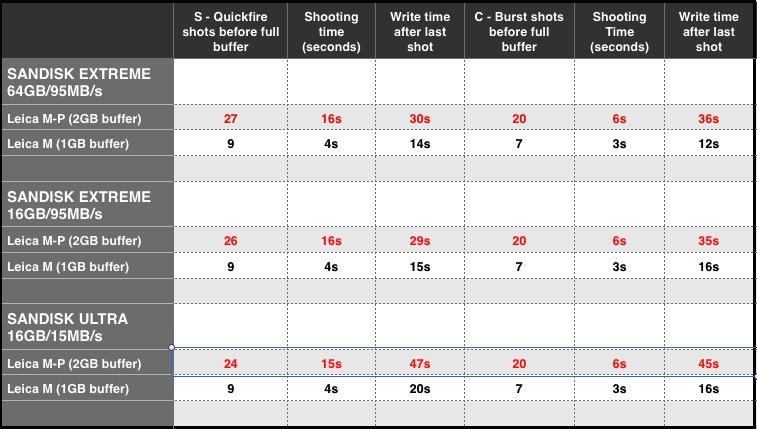When I collected a shiny silver M-P from Leica Mayfair my intention was to review it as a cosmetic upgrade on the original M, a P (for “professional”) version of the M. I assumed it would be not a lot different to the similar M9-P version of the M9. Of course I had already written about the increased buffer size but had not paid it a great deal of attention. After all, in computer terms, a bump from a miserly 1GB to a slightly less modest 2GB is hardly earth shattering. I didn’t expect much.
Yet I was wrong. The M-P handles three times as many shots before stalling sets in. Whether handling continuous (C) bursts or rapid-fire single-shots (S), the M-P is so much faster than the M.

In back-to-back testing between the M and the M-P I could capture 20 shots in continuous mode on the M-P compared with only six on the M. After that initial burst, both cameras slow down as the buffer fills and the system is forced to wait for the SD card to clear memory. Progress is erratic and this is frustrating and can lead to missed opportunities. The benefit of the increased internal memory is even more pronounced when using S mode and pressing the shutter repeatedly as fast as possible. The M-P will take 27 shots before the first sign of stalling compared with only nine with the M.
Frankly I was surprised by this new-found agility which turns the M-P into a much more accomplished performer. Often, with the M, taking a succession of quick shots can easily overload the buffer. Not so with the M-P, despite the relatively modest increase in RAM. I suspect that on the M there is about 500MB of available buffer space after the normal camera operating-system overhead. So, by doubling the RAM to 2MB Leica has tripled the available capacity, thus explaining the difference between the shooting speed of the two cameras.
Random access memory is more expensive than non-volatile solid-state memory used in SD cards or solid-state disks (SSD), for instance, yet it is not a significant overhead in relation to the high price tag of an M. As an example, Apple (never knowingly oversold when it comes to memory) charges typically £20 per gigabyte for additional RAM on a MacBook Pro. High quality chips from third-party suppliers can be had for half that. Yet here, with the M and M-P, we are talking about the difference between only one and two gigabytes. We cannot escape the conclusion that an expensive beast such as the M should have had 2GB memory from launch.
Before closing this discussion on speed, a word about that point at which the M-P slows down, which happens after 27 individual shots or a continuous burst of 20. It does not mean that the camera locks. Far from it. the M-P plods on doggedly but in a rather erratic fashion while the memory is written to the storage card. It is obvious, therefore, that faster cards will clear the buffer more quickly and will reduce the lag once that 27/20-shot threshold has been overcome.
What effect does the speed of the SD card have on performance? There is relatively little difference in the speed or number of quick shots that the camera can handle, irrespective of the type of card. But, after the first stall (following 20 continuous or 27 individual frames) the speed of the card has a significant effect on on subsequent camera performance. Faster cards, such as the 95MB/s SDs I used, allow the camera to recover sooner. After the initial burst, the fast cards cleared the memory in about 30 seconds while the slower 15MB/s card took 47 seconds. This is only to be expected, but it underlines the importance of using faster cards with the M and the M-P. Finally, there was no significant difference between using a 16GB or a 64GB card of equivalent write speed.
